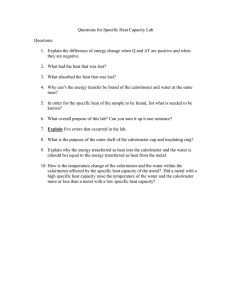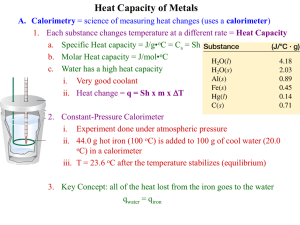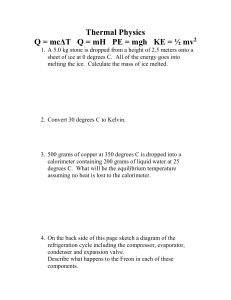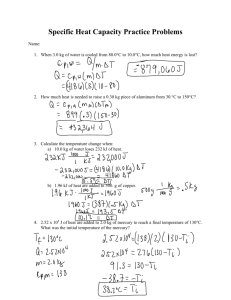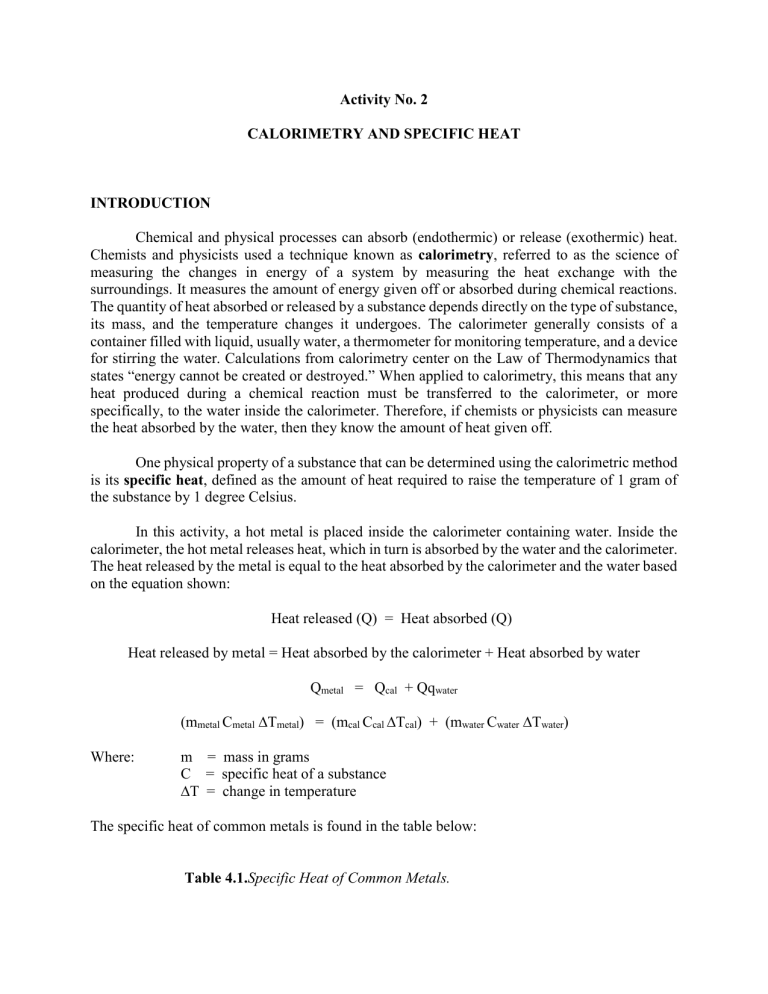
Activity No. 2 CALORIMETRY AND SPECIFIC HEAT INTRODUCTION Chemical and physical processes can absorb (endothermic) or release (exothermic) heat. Chemists and physicists used a technique known as calorimetry, referred to as the science of measuring the changes in energy of a system by measuring the heat exchange with the surroundings. It measures the amount of energy given off or absorbed during chemical reactions. The quantity of heat absorbed or released by a substance depends directly on the type of substance, its mass, and the temperature changes it undergoes. The calorimeter generally consists of a container filled with liquid, usually water, a thermometer for monitoring temperature, and a device for stirring the water. Calculations from calorimetry center on the Law of Thermodynamics that states “energy cannot be created or destroyed.” When applied to calorimetry, this means that any heat produced during a chemical reaction must be transferred to the calorimeter, or more specifically, to the water inside the calorimeter. Therefore, if chemists or physicists can measure the heat absorbed by the water, then they know the amount of heat given off. One physical property of a substance that can be determined using the calorimetric method is its specific heat, defined as the amount of heat required to raise the temperature of 1 gram of the substance by 1 degree Celsius. In this activity, a hot metal is placed inside the calorimeter containing water. Inside the calorimeter, the hot metal releases heat, which in turn is absorbed by the water and the calorimeter. The heat released by the metal is equal to the heat absorbed by the calorimeter and the water based on the equation shown: Heat released (Q) = Heat absorbed (Q) Heat released by metal = Heat absorbed by the calorimeter + Heat absorbed by water Qmetal = Qcal + Qqwater (mmetal Cmetal ∆Tmetal) = (mcal Ccal ∆Tcal) + (mwater Cwater ∆Twater) Where: m = mass in grams C = specific heat of a substance ∆T = change in temperature The specific heat of common metals is found in the table below: Table 4.1.Specific Heat of Common Metals. Metal Aluminum Brass Copper Iron Lead Magnesium Tin Water Specific Heat – C (J/g°C) (Cal/g°C) 0.910 0.220 0.380 0.090 0.390 0.092 0.460 0.108 0.130 0.031 1.050 0.243 0.382 0.054 4.184 1.000 OBJECTIVES At the end of the activity, you can: 1. calculate the amount of heat absorbed/released by a metal; 2. calculate the specific heat of a given substance (metal); 3. compare experimental data with the established or theoretical value on specific heat of the metal used; 4. calculate percent error; and 5. explain the result on the obtained percent error. APPARATUS/MATERIALS 1-Aluminum calorimeter 1-Wire gauze 1-Beaker (250 mL) 1-Thermometer 1-Alcohol lamp 1-Platform balance 1-Metal sample (150-200 grams) 1-Iron stand with ring / tripod 1-Iron clamp 1-Rubber stopper (one-hole) 1-String (1/2 meter long) Tissue paper Styrofoam crap / saw dust PROCEDURE 1. 2. 3. 4. Insulate the calorimeter with scrap Styrofoam or saw dust. Weigh the inner vessel of the calorimeter. Weigh 150 mL of water in the pre-weighed inner vessel of the calorimeter. Set the thermometer using one-holed rubber stopper. Adjust the thermometer so that the bulb will be immersed in the water after the metal is placed and that it does not touch the inner wall of the calorimeter (Figure 4.1). Thermometer Stirrer Rubber stopper Metal mass Insulator Figure 4.1. Calorimeter Setup. 5. Allow the contents to stand for 10 minutes to equilibrate and take the temperature of the water inside the calorimeter. Record this as the initial temperature, ti, of the water and the calorimeter. 6. Half-fill the 250 mL beaker with water and positioned it on the ring of the iron stand. 7. Weigh a metal sample. 8. Using a string, tie the weighed metal with a string and hang it above the beaker. Adjust it such that the metal sample will be totally immersed in the water but not touching the bottom of the beaker (Figure 4.2). Iron clamp String Metal Sample sample Figure 4.2. Heating of Metal Sample. 9. Heat the water in the beaker to boiling and leave it for 3 minutes. 10. Take the temperature of the boiling water and record it as the initial temperature, (ti)m, of the metal. 11. Remove the metal from the beaker and immediately tap it with tissue paper then place it immediately in the calorimeter. 12. Cover the calorimeter quickly and stir the contents with the stirrer. Monitor the changes in temperature inside the calorimeter. 13. If the temperature do not change anymore or stable for 1 minute, then take the temperature and record it as the final temperature, (tf)w, of the water, calorimeter and metal. 14. Calculate the heat gained by the water and the aluminum calorimeter (q = mC∆t). 15. Using the data gathered, calculate the experimental specific heat of the metal sample, C= (qwater + qcal)/(mmetal x ∆tmetal) 16. Calculate the theoretical specific heat of metal sample and compare it to the experimental specific heat obtained. 1 5. Compute the percent error. Percent Error = Theoretical Value – Experimental Value X 100% Theoretical Value 16. Record all data in the table

